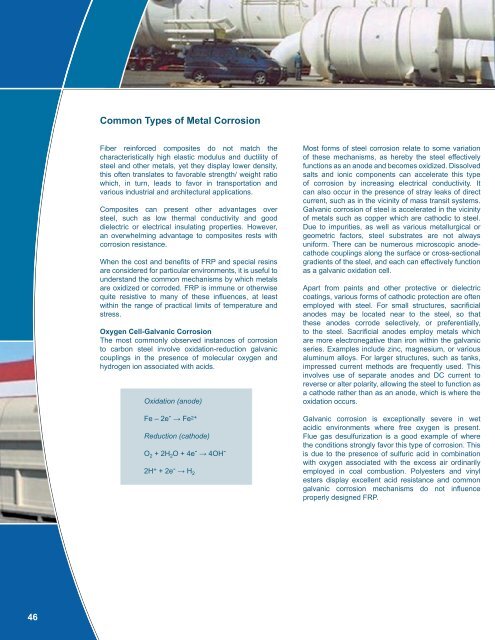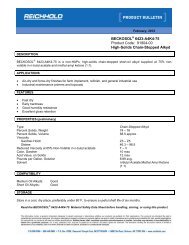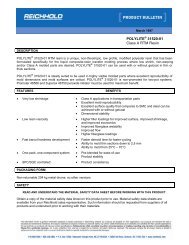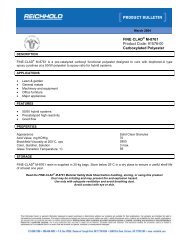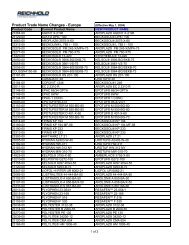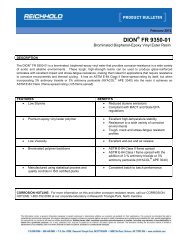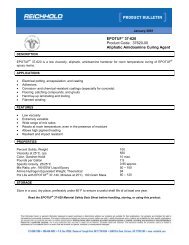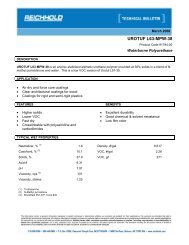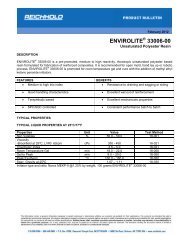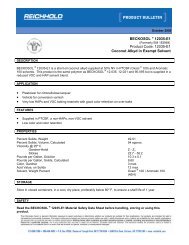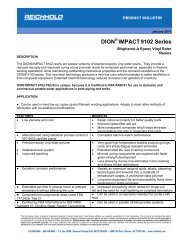CORROSION GUIDE 181108_new table content format ... - Reichhold
CORROSION GUIDE 181108_new table content format ... - Reichhold
CORROSION GUIDE 181108_new table content format ... - Reichhold
You also want an ePaper? Increase the reach of your titles
YUMPU automatically turns print PDFs into web optimized ePapers that Google loves.
Common Types of Metal Corrosion<br />
Fiber reinforced composites do not match the<br />
characteristically high elastic modulus and ductility of<br />
steel and other metals, yet they display lower density,<br />
this often translates to favorable strength/ weight ratio<br />
which, in turn, leads to favor in transportation and<br />
various industrial and architectural applications.<br />
Composites can present other advantages over<br />
steel, such as low thermal conductivity and good<br />
dielectric or electrical insulating properties. However,<br />
an overwhelming advantage to composites rests with<br />
corrosion resistance.<br />
When the cost and benefi ts of FRP and special resins<br />
are considered for particular environments, it is useful to<br />
understand the common mechanisms by which metals<br />
are oxidized or corroded. FRP is immune or otherwise<br />
quite resistive to many of these infl uences, at least<br />
within the range of practical limits of temperature and<br />
stress.<br />
Oxygen Cell-Galvanic Corrosion<br />
The most commonly observed instances of corrosion<br />
to carbon steel involve oxidation-reduction galvanic<br />
couplings in the presence of molecular oxygen and<br />
hydrogen ion associated with acids.<br />
Oxidation (anode)<br />
Fe – 2e - → Fe 2+<br />
Reduction (cathode)<br />
O 2 + 2H 2 O + 4e - → 4OH -<br />
2H + + 2e - → H 2<br />
Most forms of steel corrosion relate to some variation<br />
of these mechanisms, as hereby the steel effectively<br />
functions as an anode and becomes oxidized. Dissolved<br />
salts and ionic components can accelerate this type<br />
of corrosion by increasing electrical conductivity. It<br />
can also occur in the presence of stray leaks of direct<br />
current, such as in the vicinity of mass transit systems.<br />
Galvanic corrosion of steel is accelerated in the vicinity<br />
of metals such as copper which are cathodic to steel.<br />
Due to impurities, as well as various metallurgical or<br />
geometric factors, steel substrates are not always<br />
uniform. There can be numerous microscopic anodecathode<br />
couplings along the surface or cross-sectional<br />
gradients of the steel, and each can effectively function<br />
as a galvanic oxidation cell.<br />
Apart from paints and other protective or dielectric<br />
coatings, various forms of cathodic protection are often<br />
employed with steel. For small structures, sacrifi cial<br />
anodes may be located near to the steel, so that<br />
these anodes corrode selectively, or preferentially,<br />
to the steel. Sacrifi cial anodes employ metals which<br />
are more electronegative than iron within the galvanic<br />
series. Examples include zinc, magnesium, or various<br />
aluminum alloys. For larger structures, such as tanks,<br />
impressed current methods are frequently used. This<br />
involves use of separate anodes and DC current to<br />
reverse or alter polarity, allowing the steel to function as<br />
a cathode rather than as an anode, which is where the<br />
oxidation occurs.<br />
Galvanic corrosion is exceptionally severe in wet<br />
acidic environments where free oxygen is present.<br />
Flue gas desulfurization is a good example of where<br />
the conditions strongly favor this type of corrosion. This<br />
is due to the presence of sulfuric acid in combination<br />
with oxygen associated with the excess air ordinarily<br />
employed in coal combustion. Polyesters and vinyl<br />
esters display excellent acid resistance and common<br />
galvanic corrosion mechanisms do not infl uence<br />
properly designed FRP.<br />
46


